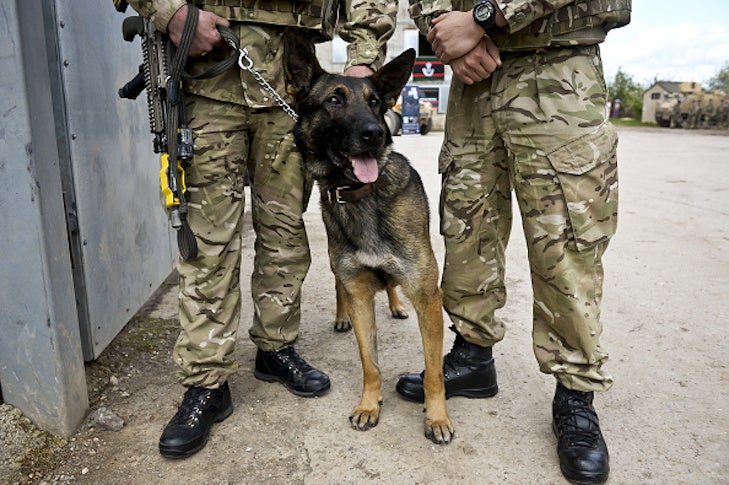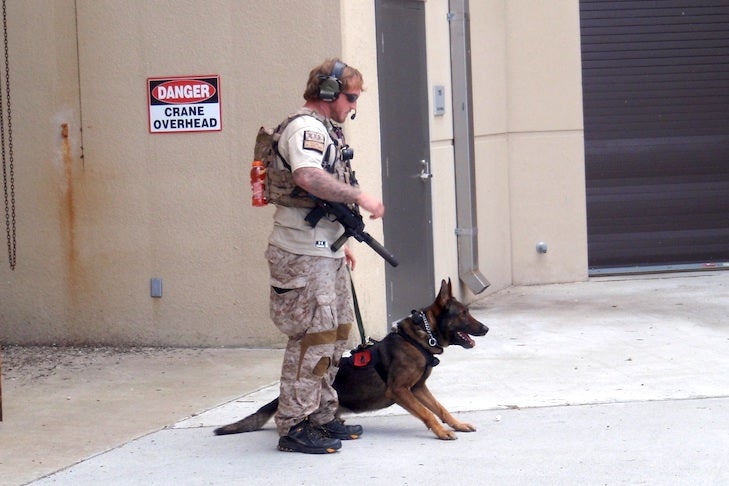
Dogs have fought alongside man since ancient times. The Egyptians, Greeks, Persians, Romans, and others used dogs as sentries and scouts and sometimes brought dogs into combat. Attila the Hun used fierce Mastiff-like breeds that were sometimes armored and sent into battle.
In more modern times, Germany created military dog-training programs late in the 19th century, and European armies used dogs during World War I to find wounded soldiers, carry supplies, and as messengers. Although dogs have worked alongside soldiers since the Civil War in the U.S., it wasn’t until World War II that the first K-9 corps was created. They were officially recognized in the U.S. on March 13, 1942. Today, military working dogs are a vital part of the armed forces, both in the U.S. and around the world. But unlike in earlier times, these dogs are treated as valuable and respected assets, soldiers on four legs.
The U.S. military uses dogs in all branches of the service. Dogs are trained for specific jobs, including tracking, explosive detection, patrol, search and rescue, and attack. Their work is invaluable, and it’s no wonder that these dogs are precious resources.
In fact, they’re in such high demand that there is currently a scarcity of trained Military Working Dogs (MWD). According to Air Force statistics, the number of dogs is about 38 percent lower than during the height of the war in Afghanistan.
Caring for these dogs in the field is a major concern. Typically, a dog’s handler has been completely responsible for his care, including veterinary first aid should the dog be wounded in the field. Now, the Department of Defense is taking steps to ensure that these canine heroes get the care they need, both immediately in the field and beyond.
Unlike in ancient times, when a dog was merely a weapon, Military Working Dogs today are seen by the troops as fellow warriors, deserving the same quality of care and medical attention as their human counterparts. Training medics how to treat wounded working dogs in real-life situations ensures that these canine heroes are getting the respect and care they have so bravely earned.
Military Working Dogs: Facts & Figures
- All military working dogs and their handlers are trained at the 341st Training Squadron located at Lackland Air Force Base in San Antonio, Texas.
- Holmdel, New Jersey, is home to the United States War Dogs Memorial. Its centerpiece is a bronze statue of a Vietnam War soldier and his dog. The memorial pays tribute historically to all of America’s war dogs.
- The earliest recorded use of canines in combat was by Alyattes of Lydia against the Cimmerians around 600 BC.
- The Military Working Dog Teams National Monument is a U.S. National Monument at Lackland Air Force Base. It was founded by John Burnam, published author, Vietnam veteran infantryman and German Shepherd Scout Dog handler (1966-68). It represents all wars since World War II and all five U.S. Armed Services (Army, Marines, Navy, Air Force, and Coast Guard). The cost of construction was provided by corporate sponsors and public donations raised by the John Burnam Memorial Foundation.
- A research and development program has been established at Lackland Air Force Base to study improved body armor and gas masks for military working dogs.
- The Department of Defense Military Working Dog Veterinary Service is a subordinate unit of the Army Public Health Center that is responsible for health care for the approximately 900 dogs/puppies at Lackland Air Force Base. That team includes 14 veterinarians, 23 technicians, and six non-medical support personnel.
- About 10 percent of military working dogs for the Department of Defense are bred at Lackland. The rest are purchased from approximately 30 vendors stateside and overseas.
- The U.S. Postal Service recognized military working dogs with a stamp set in 2019 that includes the German Shepherd Dog, Labrador Retriever, Belgian Malinois, and Dutch Shepherd.

Supply & Demand for Military Working Dogs
- A fully trained bomb detection canine is likely worth over $150,000
- The AKC was asked several years ago to assist and then implement a plan for a detection-dog breeding program within the U.S. since government agencies have for decades relied heavily on European stock to meet their growing needs.
- An AKC Detection Dog Task Force was established to raise awareness and alert U.S. breeders, citizens and research organizations about the organization’s involvement.
- Well-attended Detection Dog Task Force conferences were held the past three years, bringing experts together to determine how to better get U.S. breeders involved in producing sound dogs for explosive-detection and patrol-detection assignments.
- Over 80 percent of working/detector dogs in the U.S. are imported from Eastern Europe even though there an estimated 73 million dogs in the United States, of which about 10 million are purebred.
- Federal and local government agencies and private vendors seek puppies 10-12 months of age.
- The Department of Defense conducts evaluations at its Lackland training center and requires the seller to bring the dog there, where it will be left for up to 10 days for assessment.
AKC Detection Dog Task Force
- The Detection Dog Task Force hosts the aforementioned conferences to create a neutral environment for the vendor, breeders, and those purchasing dogs (private companies and federal government) to network and discuss issues.
- The AKC is actively meeting with government agencies to discuss the needs and the long-term solutions both in Washington, D.C., and at Lackland Air Force Base.
- The AKC has established a Patriotic Puppy Program to assist breeders in understanding how to raise detection dogs for sale to the government and private vendors. This system supports breeders and trainers with a website packed with current information, social-media updates and will soon be one of the largest databases for researching the genotype and phenotype of effective detection dogs.
- The task force has a government relations element that has proven highly successful in establishing legislation to ease the pathway for domestic breeders to supply dogs to local, state, and federal agencies in need of dogs.

